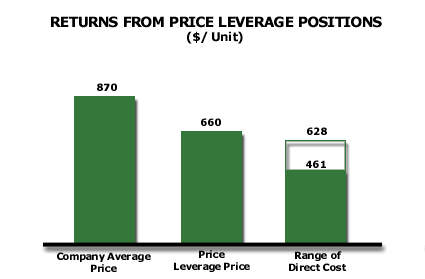Analysis 50: Returns from Price Leverage Roles
EXHIBITS:

| HOW TO INTERPRET THE ANALYSIS: This exhibit portrays the returns from Price Leverage positions, that is, those positions in the market where the Company sells its product at a low price in order to provide the customer with Price Leverage against its Primary or Secondary Role supplier. In this exhibit, the first bar represents the Company's average selling price. The second bar represents the price at which the Company sells its product when it is in a Price Leverage position. This price is $210 per unit lower than its average price and only barely covers the high end of its range of direct costs. Here, and in general, Price Leverage Roles have very poor returns.
PURPOSE: This analysis enables the Company to evaluate the profitability of Secondary and lower role positions, where the Company is in the relationship to provide Price Leverage to the customer. APPROACH: Not every company has customers in which the company's role is to provide Price Leverage. In addition, a company may not realize the fact that it is playing a Price Leverage role. To conduct this analysis, a company need not know its role. It may simply conduct this evaluation on all customer relationships in which the Company realizes low prices. The Company uses its internal data to look at the profitability of the average relationship and compares that profitability level to the profitability of the average Price Leverage relationship. The Company also compares the Price Leverage relationship prices to the Company's direct costs. The difference between the average price the Company receives and its Price Leverage role price represents the potential pay-off the Company might receive from offering a better product/service package, one that appeals to enough customers in the marketplace to avoid Price Leverage roles. The analysis also enables the Company to decide whether to continue in relationships where the Company realizes very low prices. Return to Diagnose Pricing: Price Sensitivity and Competition |
|
Recommended Reading |
| For a greater overall perspective on this subject, we recommend the following related items:
Analyses: Symptoms and Implications: Symptoms developing in the market that would suggest the need for this analysis.
Perspectives: Conclusions we have reached as a result of our long-term study and observations.
|
